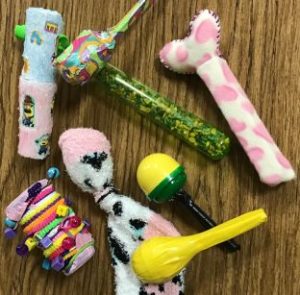While shopping for a baby gift, I noticed the variety of rattles available for infants. There were rattles that were simple, plush, noisy, colorful,  interactive, chewable and even battery operated….so many to choose from! I had a difficult time choosing one to add to my gift and it got me to thinking that new parents must feel the same way. Do infants and babies even need rattles? What is their role in infant development? It was then that I decided to add a lesson and project about rattles and how they affect development to my infant unit!
interactive, chewable and even battery operated….so many to choose from! I had a difficult time choosing one to add to my gift and it got me to thinking that new parents must feel the same way. Do infants and babies even need rattles? What is their role in infant development? It was then that I decided to add a lesson and project about rattles and how they affect development to my infant unit!
Set
- Since we are a 1:1 school, we are encouraged to be the guides on the side and provide our students with self-directed lessons. This lesson is presented as a dilemma problem that students have to investigate and research answers to, using reliable websites and web-based articles.
- I share my shopping story with students and then present them with the “Infant Rattles” worksheet either in hard copy or on Google Classroom and provide them time to research.
Materials
- iPads or Laptops
- Index Cards or Post-it-Notes Style Index Cards (affiliate link)
Activities
- After students have researched and answered the prompts, discuss their findings. I especially like to cover and make sure they understand the following key features in baby rattles:
- Safety
-
- No sharp edges,
-
- 2” in diameter or larger to avoid choking,
- Light in weight
- Age Appropriate
-
- 0-3 months: Contrasting colors/patterns that are visually appealing, held by parents, interesting sounds
-
- 3-6 months: Noisy sounds, held by baby
-
- 6-9 months: Interactive so baby can develop fine motor skills
- 9-12 months: Able to be put in baby’s mouth to soothe gums while teething
- Fun & Stimulating
-
- Includes bright colors and patterns
-
- Includes textures and sounds
-
- Includes teething support
- Interactive
- Students then have to apply what they’ve learned about rattles by creating the project titled, “Recycled Infant Rattle”. Students must complete questions that require them to provide explanations and evidence based on their rattle creations to prove they meet the key feature guidelines. The first time I did this project, I let students pick their own infant age range for their project. In the future, I think I would randomly assign age ranges so they aren’t all the same.
- Students completed the rattle project at home so it was a surprise when they brought them in and shared them with the class. I set the rattles up around the class (with age range on an index card) and had students walk around to evaluate by shaking them, etc. for the key features like an inspector would and then report any that would be inappropriate or unsafe for the infant’s age range and why. This is a great opportunity to talk about toy recalls and why they happen.
Attachments

